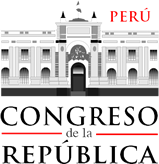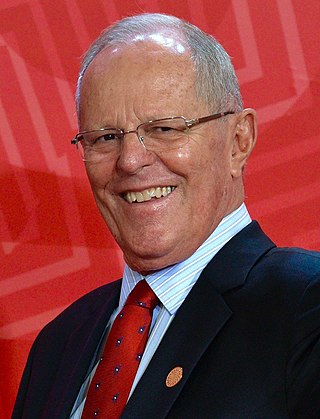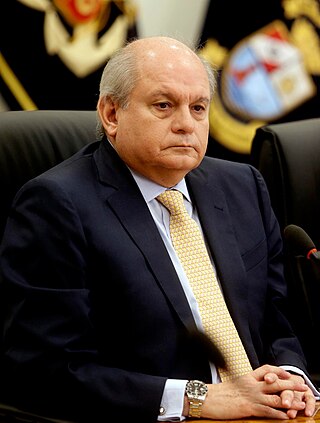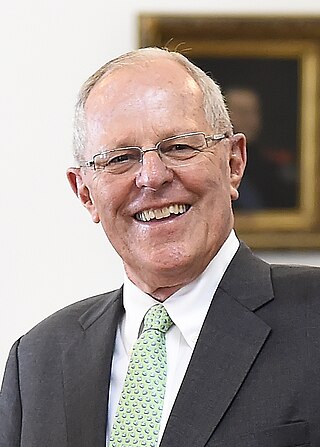The politics of the Republic of Peru takes place in a framework of a unitary semi-presidential representative democratic republic, whereby the President of Peru is both head of state and head of government, and of a pluriform multi-party system. Executive power is exercised by the President and the Government. Legislative power is vested in both the Government and the Congress. The Judiciary is independent of the executive and the legislature. The Economist Intelligence Unit rated Peru a "hybrid regime" in 2022.

The Congress of the Republic of Peru is the unicameral body that assumes legislative power in Peru. Due to broadly interpreted impeachment wording in the Constitution of Peru, the President of Peru can be removed by Congress without cause, effectively making the legislature more powerful than the executive branch. Following a ruling in February 2023 by the Constitutional Court of Peru, the body tasked with interpreting the Constitution of Peru and whose members are directly chosen by Congress, judicial oversight of the legislative body was also removed by the court, essentially giving Congress absolute control of Peru's government. Since the 2021 Peruvian general election, right wing parties held a majority in the legislature. The largest represented leftist party in Congress, Free Peru, has subsequently aligned itself with conservative and Fujimorists parties within Congress due to their institutional power.

Pedro Pablo Kuczynski Godard, also known simply as PPK, is a Peruvian economist, public administrator, and former politician who served as the 59th President of Peru from 2016 to 2018. He served as Prime Minister of Peru and as Minister of Economy and Finance during the presidency of Alejandro Toledo. Kuczynski resigned from the presidency on 23 March 2018, following a successful impeachment vote and days before a probable conviction vote. Since 10 April 2019 he has been in pretrial detention, due to an ongoing investigation on corruption, money laundering, and connections to Odebrecht, a public works company accused of paying bribes.
The Political Constitution of Republic of Peru is the supreme law of Peru. The current constitution, enacted on 31 December 1993, is Peru's fifth in the 20th century and replaced the 1979 Constitution. The Constitution was drafted by the Democratic Constituent Congress that was convened by President Alberto Fujimori during the Peruvian Constitutional Crisis of 1992 that followed his 1992 dissolution of Congress, was promulgated on 29 December 1993. A Democratic Constitutional Congress (CCD) was elected in 1992, and the final text was approved in a 1993 referendum. The Constitution was primarily created by Fujimori and supporters without the participation of any opposing entities.
The Republic of Peru has two vice presidents, the First Vice President and the Second Vice President, who are elected along with the President in democratic elections. Their only constitutional mission is to replace the President in case of death, permanent or temporary incapacity, resignation, being abroad without the permission of Congress, failure to return from abroad at fixed time, and/or dismissal or removal from office as allowed by the Constitution.Note 1 They cannot be appointed outside of general elections.

Fujimorism is the policies and the political ideology of former President of Peru Alberto Fujimori as well as the personality cult built around him, his policies and his family, especially Keiko Fujimori. The ideology is defined by authoritarianism, its support for neoliberal economics, opposition to communism, and socially and culturally conservative stances such as opposition to LGBT rights and school curriculums including gender equality or sex education. Opponents of Fujimorism are known as anti-Fujimorists.

Pedro Álvaro Cateriano Bellido is a Peruvian lawyer and politician who served as Prime Minister of Peru from July to August 2020, under Martín Vizcarra's administration. He previously served as Ollanta Humala's minister of defense from July 2012 to April 2015, and prime minister from April 2015 to July 2016.

José Pedro Castillo Terrones is a Peruvian politician, former elementary school teacher, and union leader who served as the President of Peru from 28 July 2021 to 7 December 2022. Facing imminent impeachment proceedings, on 7 December 2022, Castillo attempted to illegally dissolve Congress and rule by decree. In response, the Congress of the Republic of Peru impeached him, resulting in his removal from office.

Peruvians for Change was a centre-right party in Peru.

Martín Alberto Vizcarra Cornejo is a Peruvian engineer and politician who served as President of Peru from 2018 to 2020. Vizcarra previously served as Governor of the Department of Moquegua (2011–2014), First Vice President of Peru (2016–2018), Minister of Transport and Communications of Peru (2016–2017), and Ambassador of Peru to Canada (2017–2018), with the latter three during the presidency of Pedro Pablo Kuczynski.

On 24 December 2017, the President of Peru, Pedro Pablo Kuczynski, pardoned jailed ex-president Alberto Fujimori. Because the pardon was granted on Christmas Eve, it became known as the "indulto de Navidad".

The presidency of Pedro Pablo Kuczynski in Peru began with his inauguration on Peru independence day and ended with the president's resignation following a corruption scandal on March 23, 2018.

Since 2016, Peru has been plagued with political instability and a growing crisis, initially between the President, Pedro Pablo Kuczynski and Congress, led de facto by Keiko Fujimori. The crisis emerged in late 2016 and early 2017 as the polarization of Peruvian politics increased, as well as a growing schism between the executive and legislative branches of government. Fujimori and her Fujimorist supporters would use their control of Congress to obstruct the executive branch of successive governments, resulting with a period of political instability in Peru.

The 2019–2020 Peruvian constitutional crisis occurred between September 30, 2019, and January 14, 2020, during the presidency of Martín Vizcarra. The crisis began when President Vizcarra dissolved the Congress of Peru, citing a constitutional provision after its de facto rejection of a vote of confidence. This disbanding marked the first time such power was used by the executive, and immediately after its announcement, opposition lawmakers accused Vizcarra of staging a coup. Subsequently, Peru’s Constitutional Court declared the dissolution of Congress legal, ending the crisis.

The removal of Martín Vizcarra, president of Peru, was initiated by the Congress of Peru on 8 October 2020 under the grounds of "permanent moral incapacity". On 20 October 2020, political factions Union for Peru, Podemos Perú, and Broad Front co-signed a series of articles of impeachment against President Vizcarra for alleged cases of corruption during his term as the governor of Moquegua. Vizcarra was removed from office on 9 November 2020 in a 105–16 vote.
Karelim Lisbeth López Arredondo is a Peruvian businesswoman and lobbyist known for controversial interactions with the governments of Presidents of Peru Martín Vizcarra and Pedro Castillo.

On 7 December 2022, Pedro Castillo, the then-President of Peru, made an attempt to dissolve the Congress amidst looming removal proceedings. This move included the immediate imposition of a curfew, an attempt to establish an emergency government, and a call for the formation of a constituent assembly. Prior to this, Attorney General Patricia Benavides had accused Castillo of leading a criminal organization, a claim that contravened Article 117 of the Constitution of Peru. She had urged the Congress to remove him from office, leading to the third removal attempt against Castillo. Castillo defended his actions by arguing that the Congress, which had obstructed many of his policies, was serving oligopolistic businesses and had colluded with the Constitutional Court to undermine the executive branch, thereby creating a "congressional dictatorship". He also advocated for the immediate election of a constituent assembly, a demand that had been echoed since the 2020 Peruvian protests.

The third presidential vacancy (impeachment) process against President Pedro Castillo was an action initiated by the Congress of the Republic of Peru with the purpose of declaring the "permanent moral incapacity" of the President of the Republic, Pedro Castillo, under Article 113 of the Political Constitution of Peru.
The Judgment of the Constitutional Court of Peru over the dissolution of Congress on 30 September 2019 was court ruling determining that the actions of President of Peru Martín Vizcarra dissolving the Congress of Peru were legal within the laws outlined in the Constitution of Peru. The judgement would build upon previous rulings, determining that Congress could not regulate the motion of no confidence.

Martín Vizcarra's tenure as the 60th president of Peru began with his inauguration on January 23, 2018, and ended on November 9, 2020. Vizcarra, an centrist to center-right politician born in Lima but closely related to and raised in Moquegua, took office following the resignation of former President Pedro Pablo Kuczynski, his running mate. Vizcarra entered office amid the ongoing political crisis, that started in 2016.


















